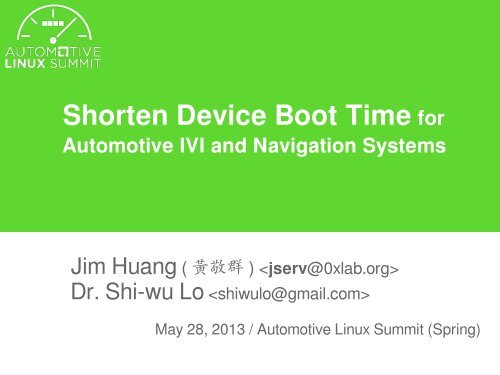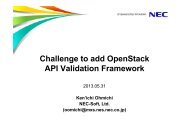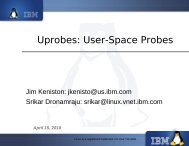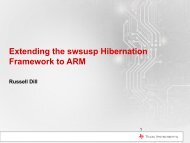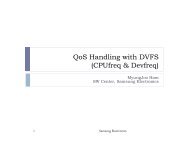Shorten Device Boot Time for Automotive IVI - The Linux Foundation
Shorten Device Boot Time for Automotive IVI - The Linux Foundation
Shorten Device Boot Time for Automotive IVI - The Linux Foundation
- No tags were found...
Create successful ePaper yourself
Turn your PDF publications into a flip-book with our unique Google optimized e-Paper software.
Disclaimer of Warranties• Technical background knowledge in thispresentation is based on the experience with ourcustomers / partners such as CSR and MediaTek.– We share non-confidential parts to endorse thecollaboration of <strong>Linux</strong> ecosystem.• We make no warranty, either express or impliedwith respect to any product, and specially disclaimthe correctness or real-world behavior.
Agenda(1) Concepts: Analysis, Strategies(2) <strong>Boot</strong> <strong>Time</strong> Reduction:from traditional to our experiments(3) ARM Hibernation(4) Checkpointing(5) Mixed model
http://elinux.org/<strong>Boot</strong>_<strong>Time</strong>
Traditional <strong>Linux</strong> Environment:printk, initcall_debug, bootchart, strace, oprofile,perf, ..
$ bootchart bootchart.tgz -f png<strong>Boot</strong>chart
StraceTrace system calls during process execution and outputtiming in<strong>for</strong>mation.$ strace -tt ls15:11:04.243357 execve("/bin/ls", ["ls"], [/* 51 vars */]) = 015:11:04.244252 brk(0) = 0x234f00015:11:04.244458 access("/etc/ld.so.nohwcap", F_OK) = -1 ENOENT15:11:04.244676 mmap(NULL, 8192, PROT_READ|PROT_WRITE,MAP_PRIVATE|MAP_ANONYMOUS, -1, 0) = 0x7f144479400015:11:04.244852 access("/etc/ld.so.preload", R_OK) = -1 ENOENT15:11:04.245096 open("/etc/ld.so.cache", O_RDONLY) = 3
OProfileOutput Example$ opreport --exclude-dependentCPU: PIII, speed 863.195 MHz (estimated)Counted CPU_CLK_UNHALTED events (clocks processor is nothalted)...450385 75.6634 cc1plus60213 10.1156 lyx29313 4.9245 XFree8611633 1.9543 as10204 1.7142 oprofiled7289 1.2245 vmlinux7066 1.1871 bash6417 1.0780 oprofile6397 1.0747 vim...
PerfRecording:$ perf record -a -f^C[ perf record: Woken up 1 times to write data ][ perf record: Captured and wrote 0.288 MB perf.data (~12567samples)]Output$ perf report --sort comm,dso,symbol|head -10# Events: 1K cycles## Overhead Command Shared Object Symbol# ........ ........... ...................... ............#35.47% firefox libxul.so [.] 0xc1b3a73.08% firefox libcairo.so.2.11000.2 [.] 0xff882.98% Xorg Xorg (deleted) [.] 0xe201c2.51% firefox firefox [.] 0x27261.49% Xorg [kernel.kallsyms] [k] find_vma0.93% perf_3.0.0 perf_3.0.0 [.] hex2u64
Perf<strong>Time</strong>chart$ perf timechart record$ perf timechart
Android Environment
<strong>Boot</strong>chartOriginal “bootchartd” is not suitable on embeddeddevices.Android re-implemented in its “init”.
To build:$ cd system/core/init$ touch init.c$ mm INIT_BOOTCHART=true<strong>Boot</strong>chart
<strong>Boot</strong>chartTo run:$ adb shell 'echo 120 > /data/bootchart-start'Remember the /data directory must be write able duringboot.Use grab-bootchart.sh to retrieve the data.
StraceModify init.rc fromservice zygote /system/bin/app_process \-Xzygote /system/bin \--zygote --start-system-serverToservice zygote /system/xbin/strace -tt \-o/data/boot.strace \/system/bin/app_process -Xzygote \/system/bin \--zygote --start-system-server
LogcatAndroid log utilityCan output timing in<strong>for</strong>mationAdjust loglevel to 6 in init.rcDisplays time spent <strong>for</strong> each command
Dalvik Method TracerMethod tracer is built into DalvikUse DDMS or using calls inside source to collect data.// start tracing to "/sdcard/calc.trace"Debug.startMethodTracing("calc");// ...// stop tracingDebug.stopMethodTracing();
StopwatchNot real stopwatchA utility in Android Framework <strong>for</strong> measuring C++ code.Output result to system log#include …{StopWatch watch("blah");/* your codes here */}
Android <strong>Boot</strong> <strong>Time</strong> Analysis
<strong>Boot</strong>-loader InitUsually constant timeAvoid init hardware multiple timesEnsure to use maximum CPU frequencyUse faster NAND/MMC reading mechanism
Kernel InitMostly usual suspectsip_auto_configUSB initFlash driver initializationFullow the standard Kernel optimizing guide:http://elinux.org/<strong>Boot</strong>_<strong>Time</strong>Avoid loading unneeded kernel module at boot time
Zygote Class PreloadingAndroid Framework has thousands of Java classesPreloaded by Zygote and instantiated in its heapTo improve Application startup time and save memoryControlled by resource: preloaded-classesframeworks/base/preloaded-classes
Zygote Class PreloadingCan use the tool in framework to adjust the list:$ adb logcat > logcat.txt$ java -p preload.jar Compile logcat.txt logcat.compiled$ java -p preload.jar PrintCsv logcat.compiledGoogle Android Developer Dianne Hackborn said:<strong>The</strong> content of the file is a “black art”You can adjust this as much as you likeBut the result maybe suboptimal
PackageManager Package ScannigEvery APK is scanned at boot timePackage management code is inefficientUses mmaped files means each access will cause pagefaultParseZipArchive() scans entire APK <strong>for</strong> only oneAndroidManifest.xml file
System Services StartingLast stage of Android bootStart every base serviceZygote start SystemServer processStart native service (SurfaceFlinger, AudioFlinger) firstStart each service sequentially
<strong>Boot</strong> <strong>Time</strong> Reduction
<strong>Boot</strong> <strong>Time</strong> Reduction:<strong>The</strong> traditional approaches mentioned by manydevelopers/speakers already
Qi <strong>Boot</strong>-loader<strong>Boot</strong>-loader Improvements:Write our faster one!Developed by Openmoko and0xlabOnly one stage boot-loaderSmall footprint ~30KCurrently support− IMX31, Samsung 24xx,Beagleboard, PandaboardKISS concept− <strong>Boot</strong> device and load kernelQi<strong>Boot</strong>-oaderU-<strong>Boot</strong> + XLoaderSize ~30K ~270K+20K<strong>Time</strong> to Kernel < 1 s > 5sUsage Product EngineeringCode Simple ComplicatedAnother example:“<strong>Boot</strong> <strong>Time</strong> Optimizations”, Alexandre Belloni, ELCE 2012
Kernel <strong>Boot</strong> <strong>Time</strong>Fullow the standard Kernel optimizing guide:http://elinux.org/<strong>Boot</strong>_<strong>Time</strong>Minimize kernel sizeUse compression or notEnable embedded optionsAvoid loading unneeded kernel module at boot time
Optimize Android InitParallize init tasksinsmod cannot be parallizedUse external scripts to init at backgroundStart services on demand
Optimize Class PreloadingTrade-off between preload class and application startuptimeSplit class to more packages to reduce dependencySave inited heap <strong>for</strong> later useShare heaps between zygote and children
Filesystem OptimizationAccording to reasearch by Linaro Kernel WGUse correct NAND configuration will improve theper<strong>for</strong>manceMMC controllers are often optimized <strong>for</strong> particularusage / filesystemAdjust the filesystem partition scheme
Toothpaste EffectObserved by Sony Developer Tim Bird“When you squeeze a tube of toothpaste, sometimes itjust moves the toothpaste somewhere else in the tube,and nothing actually comes out.”Example:“Trying to Improve Android <strong>Boot</strong> <strong>Time</strong> With Readahead”, Tim Bird,ABS 2011
Lessons learnt• Complex userspace environments like Androidusually contribute the most to boot time.– (reported) < 1s boot time often refers to minimalkernel + simplified initscript, which doesn't help• GregKH: "If you want a faster D-Bus, rewrite thedaemon / library, don't mess with the kernel." atALS 2013• Propose an intrusive technique <strong>for</strong> Android/<strong>Linux</strong>– Mixture of Hibernation and Userspacecheckpointing
Part I:Hibernation based Technologies
ARM Hibernation Solutions• swsup hibernation– Reference: “Extending the swsusp HibernationFramework to ARM”, Russell Dill at ELC 2013• Quick<strong>Boot</strong> (proprietary)• FastON
ARM Hibernation Diagram (1)4GBWrite out(seq.)Hard diskRAM
ARM Hibernation Diagram (2)Swap space(/hibernationfile)4GBHard diskRAM
ARM Hibernation Diagram (3)4GBRead-in(seq.)Hard diskRAM
ARM Hibernation Diagram (4)4GBHard diskRAM
Quick<strong>Boot</strong>Developed by Japanesecompany, UbiquitousDemand loading ofrequired page from flashRequires deepintegration of hardwareand softwareNo visible in<strong>for</strong>mation;No production record
FastONDeveloped by OSLab of National Chung ChengUniversity in Taiwan– Based on existing technologies thus requires littlemodifications to userspace– Release clean-pages be<strong>for</strong>e suspend– Swap out dirty-pages be<strong>for</strong>e save image– Image size reduced leads to faster resume time.Reference: “Swap-be<strong>for</strong>e-hibernate: a time efficientmethod to suspend an OS to a flash drive”, Dr.Shi-wu Lo
Memory AnalysisworkingsetDirty pagesClean pages1. Most of the memorystatus is unmodified(clean), with an exactcopy in secondarystorage.2. <strong>The</strong> size of working setis very very small.
FastON Diagram (1)Write-out(rand.)flash drive
FastON Diagram (2)Read-in(rand.)flash drive (fs &swp)Only working set isread and resumed!50
FastON<strong>The</strong>machine isready<strong>The</strong> time wemeasured in the“experimentalresults”0timeRead the hibernation file(load the <strong>Linux</strong> kernel)Swap in the data needed to“run” applications(load the working set)<strong>The</strong> definition of “run” is we can start to operate theapplications very smoothly. (<strong>for</strong> example, scroll downand up, key in)
<strong>Boot</strong> <strong>Time</strong>: Original vs. FastONOriginal:sizeof(main_ memory)speed seq.+ device_initFastON:sizeof(hiberfile)speed seq.+ sizeof(workingset)speed rand.(16k)+ device_init
<strong>Boot</strong> <strong>Time</strong>: Original vs. FastON<strong>The</strong> hotpath<strong>Boot</strong> timeOriginalOriginalFastONComplexity / Memory size
<strong>Boot</strong> <strong>Time</strong>: Original vs. FastON
Android Wakelocks & TuxOnIce
TuxOnIce PatchTuxOnIce (was Software Suspend 2) is a hibernationpatchsetCan save images to different locationsCan use different compresion algorithms
Suspend to DiskResume
Android WakelocksAn aggressive approach to save device powerUse wakelocks to prevent device going suspendPorting TOI to Android has to deal with wakelocksbecause MMC driver might hold a wakelockSource available: http://gitorious.org/0xlab-kernel
Example: Android on BeagleboardOMAP353x; ARM Cortex-A8 600 Mhz; 256MB RAMKernel: 2.6.32 + TOI patch<strong>Boot</strong>loader: QiAndroid 2.x system
Original <strong>Boot</strong> Sequence
Hibernation <strong>Boot</strong>
Further optimizations:No Need <strong>for</strong> full-featured<strong>Boot</strong>loader when resuming
R-LoaderNormal suspend-to-disk approach has many duplicatedef<strong>for</strong>t<strong>Boot</strong>-loader inits some hardwares<strong>Boot</strong>-loader loads the normal kernel imageKernel inits some hardwares againKernel loads the suspended kernel imageKernel resumes, inits some hardwares again
R-Loader0xlab proposed “Resume-Loader”– A customized “snapshot” bootR-Loader inits some hardware then reads thesuspended kernel image as fast as possibleJump directly to the resume pointKernel will takeover the job and inits reset hardwares
Advanced Topics <strong>for</strong> integratingHibernation with AndroidSave the heap image (like core dump) of Zygote afterpreloading classesModify Dalvik to make hibernation image after systeminit and be<strong>for</strong>e Launcher startupParallize Android initCache & Share JITed code fragment
Part II:Userspace solution: Checkpointing
Hibernation looks fine, why another?• Hibernation is sometimes harmful to userspaceespecially <strong>for</strong> recovering from file system orupdating packages, that is crucial <strong>for</strong> <strong>Linux</strong>-based“smart” devices• Post-actions are still necessary: connectivity,firmware management, security, etc.• Broken drivers are impossible to work withhibernation framework, but they usually appearfrom chip vendors though.
Basic Idea of checkpointing:Process Migration• Process Migration (in past applications)– Distributed Load Balancing– Efficient Resource Utilization• Crash Recovery and Rollback Transaction– Useful to system adminProcessesCheckpointProcessesProcessesLibrary Library LibraryTCP/IPNodeTCP/IPNodeTCP/IPNodeCommunication Channel
Ideas about Checkpointing <strong>for</strong>Android/<strong>Linux</strong>• Resume to stored state <strong>for</strong> faster Android boot time• Better product field trial experience due to regularcheckpointing• Deploy problematic states <strong>for</strong> engineering analysis anddebugging transparently• Q&A stress test purpose
Communication state checkpoint• Acquire network stack locks tofreeze TCP processing• Save receive buffers usingsocket receive system call inpeek mode• Save send buffers by walkingkernel structures• Copy control state from kernelstructures• Modify two sequence numbersin saved state to reflect emptysocket bufferscopied_seqrcv_nxtRh.RtRhRt+1Recv buffersControl<strong>Time</strong>rs,Options,etc.St+1ShStdirectaccessdirectaccessreceive()State <strong>for</strong> one socket.ShSend buffersLive Communication Statewrite_seqsnd_unaRt+1RhRtRecvbuffersControl<strong>Time</strong>rs,Options,etc.XRh St+1 ShRt+1XShStShSendbuffersCheckpoint State
Communication state restart• Create a new socket• Copy control state incheckpoint to socket structure• Restore checkpointed sendbuffer data using the socketwrite call• Deliver checkpointed receivebuffer data to application ondemandTo App by interceptedreceive system callcopied_seqrcv_nxtRhRtRecvdataControl<strong>Time</strong>rs,Options,etc.Rt+1Rt+1St+1 ShShStShLive Communication State.directupdatewrite_seqsnd_unaSend bufferswrite()RhRtRecvbuffersControl<strong>Time</strong>rs,Options,etc.Rt+1Rt+1ShShStShSendbuffersCheckpoint StateState <strong>for</strong> one socket
Existing Checkpointing mechanisms• CryoPID– http://cryopid.berlios.de/• BLCR (Berkeley Lab Checkpoint/Restart)– https://ftg.lbl.gov/projects/CheckpointRestart/• DMTCP– http://dmtcp.source<strong>for</strong>ge.net/
Implementation Considerations• Checkpointing can be implemented in– kernel modifications + helpers in userspace– pure userspace• Introduce a virtualization layer groups processes into specificstates with private virtual name space– Intercepts system calls to expose only virtual identifiers (e.g.,vpid)– Preserves resource names and dependencies acrossmigration• Mechanism to checkpoint and restart states– User and kernel-level state– Primarily uses system call handlers– File system not saved or restored
DMTCP• Distributed Multi-Threaded CheckPointing.• Works with <strong>Linux</strong> Kernel 2.6.9 and later.• Supports sequential and multi-threaded computationsacross single/multiple hosts.• Entirely in user space (no kernel modules or rootprivilege).– Transparent (no recompiling, no re-linking).• Developed in Northeastern University and MIT andunder active development since 2006.• License: GNU LGPL (allows freely using and linking)
Process StructureCT = DMTCP checkpoint threadT = User ThreadCoordinatorSignal (USR2)DMTCPProcess 1T1CTNetwork SocketT1CTT2Process Ndmtcp_checkpoint # starts coordinatordmtcp_command –c # talks to coordinatordmtcp_restart ckpt_-*.dmtcp• Coordinator: a stateless synchronization server <strong>for</strong> thedistributed checkpointing algorithm.• Checkpoint/Restart per<strong>for</strong>mance related to size of memory,disk write speed, and synchronization.
How DMTCP works (1/4)• MTCP : component <strong>for</strong> checkpoint single-process• SIGUSR2: Used internally from checkpoint thread touser threads.Checkpoint threadT1CTT21. CT sends SIGUSR2 toeach threads <strong>for</strong> suspending2. Write checkpoint imageto diskUser program3. Exit SIGUSR2 handler,and resume.
How DMTCP works (2/4)• LD_PRELOAD: Transparently preloads checkpoint libraries`dmtcphijack.so` which installs libc wrappers and checkpointingcode.• Wrappers: Only on less heavily used calls to libc– open, <strong>for</strong>k, exec, system, pipe, bind, listen,setsockopt, connect, accept, clone, close, ptsname,openlog, closelog, signal, sigaction, sigvec,sigblock, sigsetmask, sigprocmask, rt_sigprocmask,pthread_sigmask– Overhead is negligible....fd = open(path,flags);...User Programint open(const char *path,int flags){...funcs[_open](path, flags);...}dmtcphijack.soint open(const char *path,int flags){...}libc.so
How DMTCP works (3/4)• Additional wrappers when process id & thread idvirtualization is enabled– getpid, getppid, gettid, tcgetpgrp,tcsetprgrp, getgrp, setpgrp, getsid,setsid, kill, tkill, tgkill, wait, waitpid,waitid, wait3, wait4...pid = getpid();...User Programint getpid(){...real_pid = funcs[_getpid]();return pid_table[real_pid];}dmtcphijack.soint getpid(){...}libc.so
How DMTCP works (4/4)• Checkpoint image compression on-the-fly (default).• Currently only supports dynamically linking to libc.so.Support <strong>for</strong> static libc.a is feasible, but notimplemented.
Checkpoint under DMTCP(1/7)• dmtcphijack.so and libmtcp.so present in executable’smemory.– dmtcp_checkpoint CoordinatorConnect to exist coordinatoror create a new coordinatorCTCTT1T2T1T2User programUser program
Checkpoint under DMTCP(2/7)• Ask coordinator process <strong>for</strong> checkpoint viadmtcp_command.– dmtcp_command -c• DMTCP also provides API to send command or querystatusCoordinatorSend checkpointcommandCTT1 T2User programCTT1 T2User programcommand
Checkpoint under DMTCP(3/7)• Suspend user threads with SIGUSR2.Coordinator1. send command<strong>for</strong> preparecheckpointCTT1 T2User programCTT1 T2User program2. CT sends SIGUSR2 toeach threads <strong>for</strong> suspending
Checkpoint under DMTCP(4/7)• Pre-checkpoint stage• Synchronize every node and elect shared filedescriptor leaders.• Drain kernel buffers and do network handshake withpeers.Wait until all nodes are ready.Coordinator1. Report all threadexcept CT are suspendedCTT1 T2User programCTT1 T2User program2. Drain buffers
Checkpoint under DMTCP(5/7)• Write checkpoint to disk– One checkpoint file per process– ckpt__.dmtcpCoordinatorWait until all nodes ofcheckpoint are doneCTT1 T2User programCTT1 T2User programWrite checkpoint todisk separately
Checkpoint under DMTCP(6/7)• Post-Checkpint stage• Refill kernel buffersCoordinatorWait until all nodes ofpost-checkpoint are doneCTT1 T2User programCTT1 T2User programRefill buffer andre-handshake with peers.
Checkpoint under DMTCP(7/7)• Resume user threads.Send resume commandCoordinatorCTT1 T2User programCTT1 T2User programResume!
Restart under DMTCP(1/6)• Restart Process loads in memory.– dmtcp_restart ckpt__.dmtcpCoordinatorCTdmtcp_restart1. Connect to exist coordinatoror create a new coordinator2. Load process to memory
Restart under DMTCP(2/6)• Fork user programCoordinatorCTCTdmtcp_restartdmtcp_restart
Restart under DMTCP(3/6)• Reopen files and recreate ptys• Recreate and reconnect sockets• Rearrange file descriptors to initial layoutCoordinatorWail all node recreate socketand reopen file1. Reopen file/ptys/socketsCTCT2. Rearrange FD via dup2dmtcp_restartdmtcp_restart
Restart under DMTCP(4/6)• Restore memory content.• Restore stack status <strong>for</strong> checkpoint thread.FDs will preserved across execve!Coordinatordmtcp_restartexecvemtcp_restartmmap + magic!!User programCoordinatorCTCTCTCTdmtcp_restartdmtcp_restartUser programUser program
Restart under DMTCP(5/6)• Restore other threads.– Recreate thread and restore stack and context.– Restore back to the post-checkpint stage• Refill kernel bufferCoordinatorWail all nodes restoring are doneCTCT1. Memory and threadcome back now!T1T2T1T22. Refill buffersUser programUser program
...Restart under DMTCP(6/6)• Resume user threadsCoordinatorstopthisthreadThread Call Stack...while (mtcp_state_value(&thread -> state)== ST_SUSPENDED) {mtcp_state_futex (&(thread -> state),FUTEX_WAIT,ST_SUSPENDED,NULL);}...CTCTResume!T1T2T1T2User programUser program
DMTCP WorkflowRestartStart with dmtcpwrapperRe-open FDsRunRestore memoryPre-CheckpointGet checkpointcommandRestore threadsCheckpointPost-CheckpointProvide hookpoint!
OS Features supported by DMTCP• Threads, mutexes/semaphores, <strong>for</strong>k, exec• Shared memory (via mmap), TCP/IP sockets, UNIXdomain sockets, pipes, ptys, terminal modes,ownership of controlling terminals, signal handlers,open and/or shared fds, I/O (including the readlinelibrary), parent-child process relationships, process id& thread id virtualization, session and process groupids, and more…
DMTCP/Android: Additional Features(LGPL; separated from Android)• ARM Architecture support– Verified on Samsung Galaxy S2 + Android 4.0• Binder IPC– Client: supported– Server: partially supported• Ashmem: supported• Logger: supported• Properties: supported• Wakelocks: Not supportedAlready merged in upstream DMTCP
Android Binder support <strong>for</strong> DMTCP• BinderConnection– Reopen /dev/binder and reset ioctl parameters– Restore the mmap region• Hijack the whole libbinder– Prevent libbinder from interpreting data twice– Implement necessary DMTCP hooks: preCheckpoint,postCheckpoint, postRestart• Re-initialize libbinder in postRestart• <strong>The</strong> server part is partially supported because binderserver is calling a blocked ioctl and blocking the wholecheckpoint process.– We implement an early checkpoint stage to suspendsuch kind of threads.
More extensions in DMTCP/Android• Improve the hook system in DMTCP– Original design only allows one set hook function.– Allow more than one set hook function inDMTCP/Android.• Implement per thread callback hook– Restore the DVM internal thread info• Add barrier and synchronize mechanisms to DMTCP– In order to make precise program checkpointing.
Android specific modifications• Reorder code in framework– registerZygoteSocket()• <strong>The</strong> socket is inherited from the parent process `init`,which implies we can not handle it in DMTCP.– Move few initializations later than the checkpoint processsince the current binder support is incomplete.• Reserve the ashmem's file descriptor– Original behavior is to close the fd after mmap– DMTCP binds connection to one fd, so the connection will bedestroyed if that fd is closed.• Implement the missing PThread function in bionic libc– pthread_tryjoin_np is required by DMTCP,but it s not implemented in original bionic.
Technical Issues when modifyingDMTCP• ARM Architecture support is incomplete.• Different TLS implementation semantics between glibc andbionic libc– DMTCP/Android follows the techniques used in Android´sOpenGL ES package which links and defers to the slot ofTLS in bionic libc. Not elegant, but it works• PThread implementation expectation is quite different– AOSP master branch is merging libc from NetBSD, so itshould be better <strong>for</strong> compatibility.• Behavior of dynamic linker differs a lot in bionic libc.• Flags in dlopen() is not really functional.• <strong>The</strong> way to find symbol in bionic libc differs: weak symbol
Checkpoint <strong>for</strong> Zygote• Experiment environment:– Android on ARM Cortex-A9 dual (1GHz; Memory: 512 MB)with gzipwithout gzipCheckpoint time~8s ~4.5sRestart time~0.3s~0.1sImage size~3M ~17M
Observations from logcat--------- beginning of /dev/log/systemI/Vold ( 1270): Vold 2.1 (the revenge) firing up--------- beginning of /dev/log/systemI/Vold ( 1270): Vold 2.1 (the revenge) firing upD/Vold ( 1270): Volume usb state changing -1 (Initializing) -> 0 (No-Media) D/Vold ( 1270): Volume usb state changing -1 (Initializing) -> 0 (No-Media)I/Netd ( 1271): Netd 1.0 startingI/Netd ( 1271): Netd 1.0 startingI/ ( 1275): ServiceManager: 0x8062b50I/ ( 1275): ServiceManager: 0x8062b50I/ ( 1276): ServiceManager: 0x804fb98I/ ( 1276): ServiceManager: 0x804fb98I/AudioFlinger( 1276): Loaded primary audio interface from LEGACY Audio I/AudioFlinger( HW HAL (audio) 1276): Loaded primary audio interface from LEGACY Audio HWI/AudioFlinger( 1276): Using 'LEGACY Audio HW HAL' (audio.primary) as I/AudioFlinger( the primary audio 1276): interface Using 'LEGACY Audio HW HAL' (audio.primary) as the...D/AudioHardware( 1276): ### setVoiceVolume: 1.000000….D/AudioHardware( 1276): ### setVoiceVolume: 1.000000I/AudioPolicyService( 1276): [1276]Loaded audio policy from LEGACY Audio I/AudioPolicyService( HAL (audio_policy) 1276): [1276]Loaded audio policy from LEGACY Audio PE/BatteryService( 1382): usbOnlinePath not foundD/AndroidRuntime( 1902):D/dalvikvm( 1373): GC_EXPLICIT freed 14K, 1% free 6418K/6467K, paused 0D/dalvikvm( 1373): GC_EXPLICIT freed 5K, 1% free 6412K/6467K, paused 0mD/AndroidRuntime( 1902): >>>>>> AndroidRuntime START com.android.internal.os.ZygoteInit D/dalvikvm( 1373): GC_EXPLICIT
Part III:Mixted Model
Mixed Model: Hibernation + Checkpointing• Basic Idea– Swap out dirty-pages be<strong>for</strong>e save image– Reducing image size leads to faster resume time– Only the “static” working set is suspended, other partsutilizes checkpointing– Room <strong>for</strong> keeping __broken__ device drivers• However, the state machine is relatively intricatebecause of application framework awareness.
Technical Challenges of Mixed Model• Have to modify Android/Tizen framework in order tofigure the proper checkpoint to per<strong>for</strong>m.– It is not straight<strong>for</strong>ward since recent application frameworksdepend on web rendering engine as the core component.– Working-set is hard to be minimized accordingly.• Separate the device initializations into two areas:– essential zone: taken <strong>for</strong> Hibernation– post-resuming: used <strong>for</strong> checkpointing, firmwaremanagement, and connectivity → problem of maintenance• Storage access time is crucial since we touch <strong>for</strong>several times– I/O scheduler modifications are under investigation
Timing diagram of Hibernation stage(when request speed > response speed, it means I/O operations are busy)
<strong>Time</strong> diagram of <strong>Device</strong> Resuming
Conclusion• No silver bullet <strong>for</strong> device boot time optimizations• Developing an intrusive technique <strong>for</strong> Android orcomplex <strong>Linux</strong> systems is possible <strong>for</strong> designaspects• <strong>The</strong> quality of device driver and file system causesessential impacts as well no matter how a newtechnique is introduced.• Mixed model can be used <strong>for</strong> the production ofdedicated systems such as digital TV andautomotive <strong>IVI</strong>.
Reference• Embedded <strong>Linux</strong> Wiki: http://elinux.org/<strong>Boot</strong>_<strong>Time</strong>• “DMTCP: An New <strong>Linux</strong> Checkpointing Mechanism<strong>for</strong> Vanilla Universe Job”, Condor Project, University ofWisconsin-Madison• “Checkpointing using DMTCP, Condor, Matlab andFReD”, Gene Cooperman, Northeastern University, Boston• “<strong>Boot</strong> <strong>Time</strong> Optimizations”, Alexandre Belloni, ELCE 2012• “Extending the swsusp Hibernation Framework toARM”, Russell Dill, ELC 2013
http://0xlab.org


